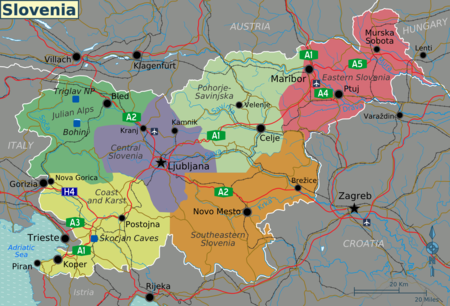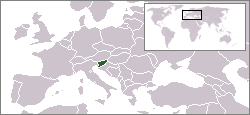Slovenia (Slovenian: Slovenija) is a country in central Europe that lies in the eastern Alps, at the northern end of the Adriatic Sea. It is sometimes considered to be a Balkan country. Despite its small size, Slovenia has a surprising variety of terrain, ranging from the beaches of the Mediterranean to the peaks of the Julian Alps and the rolling hills of the south. Slovenia is also home to some of the finest scenery in the "New Europe". The transition from socialism to the European common market economy has gone well and serves as a model for other nations on the same track to follow.
Regions
[edit]| Coast and Karst The southwestern corner of Slovenia with rolling hills, awe-inspiring caves and the country's 47 km of coastline. |
| Julian Alps The mountainous northwest with hiking, rafting, postcard pretty lakes and Mt Triglav, the symbolic heart of Slovenia. |
| Central Slovenia The urban part with capital Ljubljana and the surrounding region. |
| Southeastern Slovenia The region around the Krka and lower Sava Rivers. |
| Pohorje-Savinjska Mountains in the north and the Savinja River Valley. |
| Eastern Slovenia The region around the Drava and Mura Rivers, with plenty of vineyards and a Hungarian influence in the east. |
Cities
[edit]
- 1 Ljubljana – The picturesque capital
- 2 Bled – A romantic mountain lake complete with its own castle and island
- 3 Celje – One of Slovenia's oldest cities
- 4 Koper/Capodistria – A lovely Venetian city, largest on Slovenian coastline
- 5 Maribor – Slovenia's second largest city
- 6 Nova Gorica – The city on the border with Italy
- 7 Piran/Pirano – A gorgeous Venetian port
- 8 Postojna – The site of the gigantic Postojna caves
- 9 Ptuj – One of Slovenia's oldest cities
Other destinations
[edit]- 1 Škocjan Caves – Less commercial than Postojna but similarly impressive, a UNESCO World Heritage Site.
- 2 Triglav National Park – Home to national symbol Mt. Triglav and mythical golden chamois Zlatorog.
- 3 Soča Valley – Soča river, with its emerald colour, is one of the most beautiful European Alpine rivers.
Understand
[edit]History
[edit]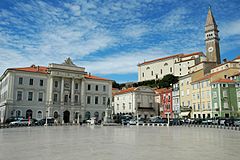
Slavic ancestors of Slovenians came from eastern parts of Europe and inhabited territory north of present Slovenian territory in the 6th century AD. They established a state called Caranthania (Karantanija in Slovene), which was an early example of parliamentary democracy in Europe. The ruler (knez in Slovene) was elected by popular vote. The Caranthanians were later defeated by Bavarians and Franks, who subjugated them. They were Christianized, but they preserved many rituals of their pagan religion, and above all, they preserved their native language. The Slovene lands were part of the Holy Roman Empire and Austria under the Habsburg dynasty until 1918, when the Slovenes joined the Serbs and Croats in forming a new south-Slavic state ruled by Serbian Karađorđević dynasty called the Kingdom of Serbs, Croats and Slovenians ("Kraljevina Srbov, Hrvatov in Slovencev" in Slovene), renamed Yugoslavia in 1929. In WWII, Slovenia was invaded and occupied by Germans, Italians and Hungarians, leading to a parallel civil war between pro-communist liberation forces (Partizani) and axis-sponsored anti-communist reactionary factions ("Belogardisti" and Domobranci). The victory of the Allies and consequently the Partizans resulted in a violent mass exodus of those who had fought with the occupying forces, including most of the native German and Italian minorities.
After World War II, Slovenia became a republic in the reestablished Yugoslavia, which made small territorial gains from Italy. Although communist, Yugoslavia left the Soviet bloc in 1948.
Slovenia was already more economically advanced than nations behind the Iron Curtain prior to European integration. Dissatisfied with the exercise of power in Belgrade, the Slovenes gained their independence in 1991 with minimal bloodshed. Following independence and the transition to democracy, Slovenia experienced rapid economic growth, and is today widely regarded as having advanced to developed country status, having been classified as an "advanced economy" by the International Monetary Fund (IMF) since 2007, the only former Yugoslav country to have this distinction as of 2021. In 2004, Slovenia joined the European Union and NATO. In 2007, Slovenia adopted the euro, completing a quick and efficient accession to Europe and the EU.
Culture
[edit]|
Totalitarian disco
Without a doubt Slovenia's most misunderstood export, industrial band Laibach (also the German name of Ljubljana) and their Neue Slowenische Kunst (NSK) collective emerged from the coal mining town of Trbovlje to smash their first sledgehammer in 1980 and, despite the best efforts of the state they skewered, went on to outlast Yugoslavia and are still going strong. Using totalitarian imagery stretched to the limit, with band members decked out in military uniforms, memorable moments include reworking Queen's starry-eyed "One Vision" into a Wagnerian march (sung in German, of course) that would make a Teuton blanch. Keep an eye on the NSK website and try to catch a concert when in town. |
Slovenia lies at the tripoint of the Germanic, Latin, and Slavic cultures, and Slovenes are fiercely proud of their culture. Two names you will run into over and over again are national poet France Prešeren (1800-1849), who penned (among other things) the Slovenian national anthem, and the architect Jože Plečnik (1872-1957), credited with Ljubljana's iconic Tromostovje bridges and, seemingly, half the modern buildings in the country. It was the monks of the Catholic Church that kept Slovene alive over the centuries of relentless Germanization from the north. As a result Slovene survived in its unique form different than Serbo-Croatian to the south. Part of both the countryside and city architecture in the Julian Alps shares a lot in common with neighboring Austria, including countless roadside shrines and pretty baroque steeples, giving the interior of the nation a truly Alpine flavor. One could easily mistake parts of mountainous Slovenia for Tyrol, Salzburg or Bavaria. In modern times, industrial band Laibach (see box) has served to put Slovenia on the map. In the decades before them, Slavko Avsenik and his Oberkrainer (as known in German) did the same.
Climate
[edit]Mediterranean climate on the coast, mountain climate in the Alps with mild summers and freezing winters and continental climate with hot summers and freezing winters in the plateaus and valleys to the east.
Terrain
[edit]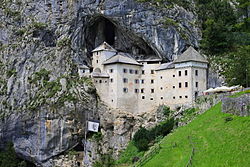
A short coastal strip on the Adriatic, an Alpine mountain region adjacent to Italy and Austria, mixed mountain and valleys with numerous rivers to the east and Pannonian Basin in northeast. Central Ljubljana valley with Ljubljana marshes in the southern part. In the southwest there is the Karst (Kras in Slovene, Carso in Italian) (where the name for karst topography as a whole actually comes from). The Karst region is a barren but beautiful limestone region directly north of the Italian city of Trieste.
- Natural hazards – flooding and earthquakes
- Highest point – Triglav (2,864 m)
- Lowest point – Adriatic Sea (0 m)
Visitor information
[edit]Talk
[edit]- See also: Slovenian phrasebook
Slovenian, the national language, is spoken as the mother tongue by 91% of the population, but there are also small Italian (concentrated on the Primorska coast) and somewhat bigger Hungarian (in Prekmurje to the northeast) minorities. Historically, and prior to the end of World War II there was also a significant German speaking minority. Conversely, Slovenian is spoken in border regions of neighbouring countries.
English is widely spoken by younger adults who grew up after the fall of Yugoslavia. People who grew up during the Yugoslav era, on the other hand, usually speak no English. Many people you come into contact with as a tourist will speak English, and may have some functional knowledge of German, in particular in Eastern Slovenia, and of Italian in the coastal region where Italian is a co-official language. Serbo-Croatian is very closely related to Slovenian and widely understood.
The Slovenian school system heavily promotes the teaching of foreign languages from primary school onwards. Children study two foreign languages (most commonly English and German) by the time they get to grammar school. A typical grammar school often teaches an optional third foreign language, Spanish, Italian, or French. Many speak English well with older people speaking German. Some older people may speak Russian as it was a compulsory second language in schools for a few years after the World War II.
Get in
[edit]Entry requirements
[edit]Slovenia is a member of the Schengen Agreement. See Travelling around the Schengen Area for more information on how the scheme works, what countries are members and what the requirements are for your nationality. In summary:
- There are normally no immigration controls between countries that have signed and implemented the treaty; there may be such controls temporarily, such as in connection with important events and various crises.
- There may be identity checks before boarding international flights or ferries, even between Schengen countries, carried out by the operators.
- Citizens of the EEA countries and Switzerland do not need visas for travelling in the Schengen area, and may stay up to 90 days with no requirements other than having a valid ID card or passport. See European Union#EEA citizens.
- Normal visas granted by any Schengen member are valid in all countries that have signed and implemented the treaty (with exceptions for some overseas territories). The granting country may offer additional rights (such as longer stays or right to work) that apply only locally.
Citizens of the above countries are permitted to work in Slovenia without the need to obtain a visa or any further authorisation for the period of their 90 day visa-free stay. However, this ability to work visa-free does not necessarily extend to other Schengen countries.
By bus
[edit]- See also: Bus travel in former Yugoslavia

The Ljubljana Bus Station (Avtobusna Postaja Ljubljana) provides composite information about international and airport bus services.
Connections between the Italian city of Trieste and nearby Koper and Piran are frequent on weekdays. There's also a daily bus between Trieste and Ljubljana. In addition, services between Gorizia (Italy) and its twin town of Nova Gorica (Slovenia) are at least hourly throughout the day although the journey is easily walkable. This offers an ideal connection between the Italian and Slovene railway networks or an alternative entry point from Trieste's Ronchi Airport or the city of Venice.
By plane
[edit]- Ljubljana Jože Pučnik Airport is Slovenia's primary international airport.
- Maribor has Slovenia's second busiest airport, even if it had less than 10,000 passengers in 2016.
There are other options worth exploring in neighbouring countries. There are three Croatian airports within close proximity of the Slovene border: Zagreb (ZAG IATA) is a worthwhile point of entry to consider if you want to visit the eastern parts of Slovenia, while Pula (PUY IATA) and Rijeka (RJK IATA) are within a one-hour drive from most towns in southern and south-western Slovenia. In Italy, a convenient gateway, especially to western Slovenia, is the airport of Trieste (TRS IATA), a rapidly growing regional airport within an hour's drive from Ljubljana via super highway. Further away in Italy, Venice and Treviso (TSF IATA) offer a vast array of destinations around the world. They can be good for day trips, though bus and railway connections between these airports and Slovenia are lackluster. Finally, the Austrian airports of Klagenfurt (KLU IATA) and Graz (GRZ IATA) are also options for Northern Slovenia, though the flight offerings are limited.
By train
[edit]Slovenia is well connected to Austria, Croatia and Hungary by train. The most popular routes connect from Vienna or Villach in Austria (in good weather, this journey past the Julian Alps is spectacular), from Budapest in Hungary , and from Zagreb in Croatia. All lines converge on the capital Ljubljana.
Italian Railways operate a daily Trieste - Ljubljana train, and a daily Udine - Trieste - Ljubljana train. A 2nd class ticket costs €8 for Trieste-Ljubljana, and €15.60 for Udine-Ljubljana.
Slovenia Railways[dead link] is the national railway company. There are many international routes[dead link], and special offers[dead link] exist for some destinations, so you should consider informing yourself about that in advance. There are destinations, which have tickets on contingency basis, meaning that they could run out fast, but are usually a lot cheaper, such as Ljubljana - Prague line (cooperation between SŽ and Czech railways), €58 for a return ticket (compared to a normal price of €200). For return trips originating in Slovenia, "City Star" tickets, which are open-dated, but usually require a weekend stay, are often the cheapest choice[dead link]. Also, be aware that you also receive a discount with the Euro<26 youth card [dead link] on most international lines (of course the discount does not stack up if you already have a special deal). The same card also applies for all domestic lines, with a 30% discount.
The quality and comfort of the trains on international routes varies significantly. The unwritten rule is that everything heading up north from Ljubljana has a pretty good standard. The trains usually have restaurants on board, with clean and modern toilets. The same can not be guaranteed for the lines heading south (such as Belgrade, Sofia, Skopje or Thessaloniki), so be sure to carry a supply of food and beverages on board (water and coffee is available in every sleeping compartment), when heading to or from Ljubljana from the Balkans, with the train. However, the express services which run to Zagreb (usually starting in Munich, Germany) are very high quality - but the price shows this.
By car
[edit]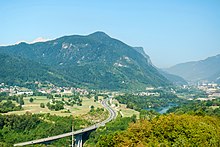
Slovenia has an excellent highway network[dead link] connected to neighboring countries. Slovenia demands that all vehicles with a permissible weight of up to 3.5 tons buy a vignette (road tax) before using motorways or expressways. For passenger vehicles, the vignette costs €15 for a week, €30 for a month, or €95 for a year. For motorcyclists, this costs €7.50 per week, €25 for 6 months and €47.50 for a year. Using motorways without a vignette will result in a fine of €300 or more. Vignettes are sold at the border, please remember to ask (the border agents are supposed to give you a flyer advising you to buy one, but they don't always do that. The posted signs advising you to buy a vignette are in Slovene only).
When entering through northern neighbor Austria, you also need a separate vignette to use the Austrian highway network.
From Austria
[edit]From Italy
[edit]- Venice → Trieste → Koper
- Venice → Gorizia → Nova Gorica
- Tarvisio → Rateče → Kranjska Gora → Jesenice
By boat
[edit]- There is a fast ferry between Venice and Izola, running with an irregular schedule mainly during the summer season (for the timetable see [dead link]). The journey takes 3 hours.
- Venezialines run one fast ferry per week between Venice and Piran.
- During the summer months, there is a fast craft service operated by Trieste Lines between Trieste (Italy), Piran (Slovenia), Poreč (Croatia) and Rovinj (Croatia). The portion of the journey between Piran and Trieste lasts 30 minutes, which is pretty much the same as the same journey in a car.
Get around
[edit]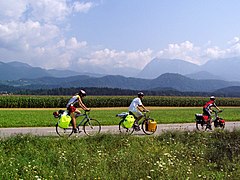
Slovenia is a relatively small country and getting around is generally quick and painless. However, the explosive growth in car ownership has meant tougher times for public transport, and bus schedules in particular have been slashed, so some planning ahead is required. Services are sparse on Saturdays and very limited indeed on Sundays.
By train
[edit]|
Timetable decoder
D — Monday-Friday |
Slovenia's train network, operated by Slovenske železnice (SŽ)[dead link] will get you to most destinations in the country, although there are some annoying gaps in the network and routes can be circuitous, so going from anywhere to anywhere usually requires a change at Ljubljana. Trains are, however, some 30% cheaper than buses and return discounts are available on weekends. Buy tickets before you board, as there's a surcharge for any tickets bought from the conductor—except if tickets are not sold at the station. A €1.50 surcharge also applies to any InterCity trains. Bicycle ticket is €1.5 (€3.5 for E-bicycle) and it is valid for whole calendar-day.
Quite a bit of money and effort has been put into modernizing the system and the newest trains are as nice as anything you'll find in Western Europe, and although rural stations are often quite basic, most stations are extremely well kept with flowers decorating the platforms throughout summer months. In particular, the name of the station is typically only visible on a single sign on the station building itself, so figuring out where you are means craning your neck a lot. Newer trains do have a voice announcement system that tells you to which station you are approaching. Trains are punctual (except some international ones), so check the expected arrival time and some previous station names to be sure where to get off. For figuring out your next train from a station; electronic signboards are a rarity (outside Ljubljana), but printed schedules are always available: odhod (yellow) means departures, while prihod (white) is arrivals, although this is usually indicated in both English and Slovene.
Most of trains have free Wi-Fi.
By bus
[edit]Buses fill in the gaps, and are usually a better option for some towns not directly served from Ljubljana by train (e.g. Bled, Piran). Some bigger stations have handy electronic search engines for schedules and fares. Slovenia's leading long-distance bus companies are Arriva Slovenija[dead link] and FlixBus.
By car
[edit]
Traffic is Slovenia's biggest safety risk. Accidents are caused by excessive speeds on motorways, excessive speeds on smaller roads, reckless overtaking and the narrowness of mountain and coastal roads combined with driving habits. The winter tyre ban is in force from 15 November to 15 March. The drink-driving limit is 0.5. Traffic police in Slovenia are not very visible.
Slovenia's roads are for the most part well maintained and well signposted, and you won't have a problem if you drive or hire a car. Having a car certainly does add a level of mobility and self-direction that you won't get by train or bus.
There are a number of car rental and taxi businesses in Ljubljana. The big international companies are all represented, but if you are on a budget, the local companies have some nice offers if you do not mind using a car which is a few years old.
Slovenian railways also offer Motorail[dead link] on some routes where you can take your car on the train and save the stress of driving.
See
[edit]Slovenian cities leave no doubt about historic influence played by Austrian and Italian architecture: Ljubljana is not unlike Prague and Piran could be easily mistaken for a small Italian town. While cities are far from boring, the real Slovenian must-see is its diverse and unspoiled nature.
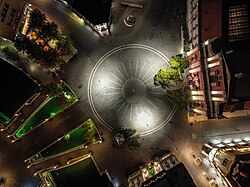
- Visit the alpine resort of Bled and its romantic lake with an island, but continue towards Srednja vas to see some traditional villages, or hitch a ride to Pokljuka mountain, a good starting point for hikes into Julian Alps.
- Enjoy the 5.3 km ride through Postojna caves, the longest publicly accessible depth of any cave system in the world, with massive stalactites and stalagmites.
- After visiting the lively coastal town of Piran, a trip to the serene salt works of nearby Sečovlje will feel like stepping out of this world.
- Soča river is said to be one of the few rivers in the world to retain their emerald green color throughout its length. The Trenta valley, through which it flows before crossing to Italy, is also well worth seeing.
- Slovenian pint-size baroque capital Ljubljana is nice in any season but especially popular in December due to its abundant but tasteful decoration.
Do
[edit]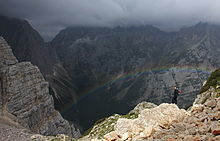
There are many great opportunities for activity holidays in Slovenia: The mountains and rivers of the Julian Alps provide the perfect location for hiking, mountain biking, rafting and kayaking. The southern part of Slovenia is an area of numerous caves. You can enjoy different spa resorts in the eastern part, take a dive in the Adriatic Sea, experience the Slovene cities, go skiing, or enjoy in the countryside tasting Slovene cuisine and local wine. Since Slovenia is a small country, you can discover it in a few days. Therefore you can visit Ljubljana (the capital city), the Julian Alps, Karst region, alpine lakes within several days. A more detailed look at the country, however, requires much more time.
- Adrenaline adventures in the Posočje area, you can stay in Ljubljana and, in a short distance away, discover the amazing North-Western area of Slovenia called Posočje and Triglav National Park—canyoning (soteskanje), rafting and para-gliding are available. Because of the relatively new appearance of Slovenia on the national stage of extreme sports, these are much less expensive to participate in than other European countries, such as the UK or Switzerland. These activities are particularly prevalent in Bohinj, Bovec, Kranjska Gora, and other north-western cities.
- There are more than 8,000 known caves in Slovenia, including the tourist area of Postojna and the UNESCO listed Škocjan Caves.
- Take advantage of beautiful nature in the Alps and go hiking, cross-country skiing, Nordic walking, or mountain biking, weather permitting. If you do so, it may be worth investigating in a membership in the Slovenian Alpine Association (PZS)[dead link], which gives a discount for accommodation at mountain huts run by member associations and includes an accident and rescue insurance.
- Visit of one many spa resorts in Slovenia.
- Visit the Slovene seaside and swim in the Adriatic Sea. Try local seafood and visit the towns of Piran and Portorož.
- Visit one of the golf courses in Slovenia.
- Skiing in the Julian Alps is popular in the winter. More popular ski resorts are: Kranjska Gora, Krvavec, Vogel, Rogla, Cerkno, Kanin, and Mariborsko Pohorje.
Buy
[edit]Money
[edit]|
Exchange rates for euros
As of October 2024:
Exchange rates fluctuate. Current rates for these and other currencies are available from XE.com |
Slovenia uses the euro, like several other European countries. One euro is divided into 100 cents. The official symbol for the euro is €, and its ISO code is EUR. There is no official symbol for the cent.
All banknotes and coins of this common currency are legal tender within all the countries, except that low-denomination coins (one and two cent) are phased out in some of them. The banknotes look the same across countries, while coins have a standard common design on the reverse, expressing the value, and a national country-specific design on the obverse. The obverse is also used for different designs of commemorative coins. The design of the obverse does not affect the coin's acceptability.
The euro replaced the Slovenian tolar (SIT).
ATMs
[edit]ATMs are available countrywide, and it is generally good to have a card from providers like Visa or MasterCard. In smaller towns or villages ATMs become more sparse.
Here are ATM fees of local banks for euro withdrawals:
- Addiko Bank – €0
- Deželna banka Slovenije – €0
- Intesa Sanpaolo – €0
- UniCredit – €0
- skbbanka – €4
- NLB – €6
Prices
[edit]Prices are high compared to most of Eastern Europe (except Croatia), but lower compared to Italy or Austria. Although prices do vary quite a bit, it really depends on the location. For example, a beer (0.5L) in a pub in "Stara Ljubljana" (literally "Old (Town) Ljubljana") would cost you around €3, while a beer outside Ljubljana would cost around €1.80. A budget minded traveller can hold his own, if they are smart. For example buying your groceries in a large store (supermarket), such are Mercator, Tuš, Spar, Lidl, Hofer, E.Leclerc etc., will be likely cheaper than buying on the market, or in a small store, etc.
A value-added tax (VAT) of 22% (with a reduced rate of 9.5% usually applied to food, including some soft drinks) is charged on most purchases—this is always included in the price displayed. Note that if you are not an EU resident, you are entitled to VAT tax return for purchases over a certain value. Ask the cashier to write down your name on your bill (račun, pronounced rah-CHOON) and show this bill when you leave Slovenia through Jože Pučnik (formerly Brnik) airport.
Tipping
[edit]Most Slovenians do not feel that tipping is obligatory. They might round-up the bill to the next euro for convenience or, occasionally, tip for a truly exceptional service, but generally tipping is not practised.
Eat
[edit]People from Slovenia's northern neighbour Austria come to Slovenia just for the food; with a mixture of Subalpine, Italian, Austrian, Hungarian and Balkan cuisine, most people will find something to their liking, unless they're strict vegetarians. Many claim that the pizza here is as good as or even better than in neighboring Italy.
Cuisine
[edit]Generally speaking, Slovenian food is heavy, meaty and plain. A typical three-course meal starts with a soup (juha), often just beef (goveja) or chicken (piščančja) broth with egg noodles (rezanci), and then a meat dish served with potatoes (krompir) and a vinegary fresh salad (solata). Fresh bread (kruh) is often served on the side and is uniformly delicious.
Common mains include cutlets (zrezek), sausage (klobasa) and goulash (golaž), all usually prepared from pork (svinjina), lamb (jagnjetina) and game (divjačina), but there is a large choice of fish (ribe) and seafood even further away from the coast. Popular Italian imports include all sorts of pasta (testenine), pizza (pica), ravioli (ravioli) and risotto (rižota). A major event in the countryside still today is the slaughtering of a pig from which many various products are made: blood sausage (krvavica), roasts (pečenka), stuffed tripe (polnjeni vampi), smoked sausage (prekajena salama), salami (salama), ham (šunka) and bacon (slanina). Recipes for the preparation of poultry (perutnina), especially turkey (puran), goose (gos), duck (raca) and capon (kopun), have been preserved for many centuries. Chicken (piščanec) is also common. Squid is fairly common and reasonably priced.
Uniquely Slovenian dishes are available, but you won't find them on every menu, so here are some to look out for:
- Kraški pršut – Air-dried ham, similar to but not the same as Italian prosciutto
- štruklji – Dumplings which Slovenians prepare in 70 different ways stuffed with sweet fillings, meat or vegetables
- žganci – A type of polenta (ajdovi žganci are made of buckwheat)
- žlikrofi – Potato dumplings similar to gnocchi, specialty of the Idrija region
- jota – A type of soup made of beans, sauerkraut, potatoes, bacon, spare ribs, and the main seasoning is garlic.
Some Slovenian desserts can also be found:
- potica – A type of nut roll for holiday occasions also prepared with the widest variety of fillings.
- prekmurska gibanica – A very heavy cakelike pastry of poppy seeds, walnuts, apples, raisins, cheese etc.
Places to eat
[edit]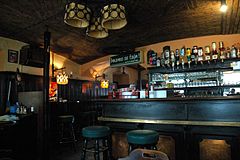
At the top of the food chain is the restavracija (restaurant), which could be a fancy restaurant with waiters and tablecloths or just a typical Chinese restaurant. More common in the countryside are the gostilna and gostišče, rustic inns serving hearty Slovene fare. Lunch sets (dnevno kosilo) cost around €7 for three courses (soup, salad and main) and the large portions are usually well worth the paltry cost.
Fast food is, invariably, cheap, greasy and (more often than not) terrible. It's best to steer clear of the local mutation of the hamburger, which is served up in grills and snack bars known as okrepčevalnica. There is no real Slovenian fast food, but Slovenians have adopted greasy Balkan grills like pleskavica (a spiced-up hamburger patty) and čevapčiči (spicy meatballs) are ubiquitous, but one of the more tasty if not healthy options is the Bosnian speciality burek, a large, flaky pastry stuffed with either meat (mesni), cheese (sirni) or apple (jabolčni), often sold for as little as €2. Many fast food places make döner kebabs, and they are among the most popular fast foods in Slovenia. It's very difficult to find a bad kebab in Slovenia, and they are sold in many places nationwide.
Dietary restrictions
[edit]Slovenia is not the best of destinations for a vegetarian, although even the smokiest inn can usually whip up a decent fresh salad (solata) and fried vegetables on request. Lacto-ovo vegetarians will have it easy in Slovenia, while strict vegans won't find more than a handful of vegan restaurants in the country (most of them in Ljubljana). It is wise to know that even the smallest store has its healthy food shelves with many non-animal alternatives. In the cities the Mediterranean chick-pea staple falafel and its cousin the vegiburger have made some inroads on fast-food menus. Many restaurants offer a "vegetarian plate", which includes potatoes, fresh or boiled vegetables and soya "steak".
In coastal cities, there is a paradise for pescetarians and seafood lovers. Local specialities are fish, squids, mussels, and octopus.
Drink
[edit]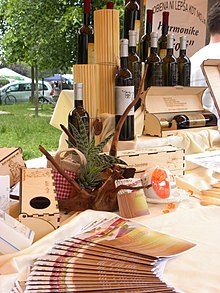
In proper Slovene style, all bases are covered for drinks and you can get very good Slovenian beers, wines and spirits. Tap water is generally drinkable.
Coffee and tea
[edit]In Slovenia, coffee (kava) usually means an espresso, and cafes (kavarna) are a common sight with a basic cup costing €1–1.50. One can also order coffee with milk (kava z mlekom) or whipped cream (kava s smetano). Coffee culture is widespread in Slovenia, and one can see Slovenes with friends sitting in the same café for hours. When invited to a cup of coffee at someone's home, expect Turkish coffee. Tea (čaj) is nowhere near as popular, and if they do drink it (mostly in the winter), Slovenes prefer all sorts of fruit-flavored and herbal teas over a basic black cup. Tea is served with honey and lemon by request.
Beer
[edit]Beer (pivo) is the most popular tipple and the main brands are Laško and Union. Adam Ravbar beer is good quality and is usually hard to find anywhere except in their small brewery (located in Domžale, a town about 10 km north of Ljubljana). A bottle or jug will cost you €2.50 in a pub (pivnica). Ask for veliko (large) for 0.5L and malo (small) for 0.3L. Also try "Union Radler Grapefruit", a refreshing mixture of beer and grapefruit juice.
Wine
[edit]Despite what you might think if you've ever sampled an exported sickly sweet Riesling, Slovenian wine (vino) can be quite good — as in Germany, they keep the best stuff for themselves. Generally, the Goriška brda region produces the best reds and the drier whites (in a more Italian/French style), while the Štajerska region produces the best semi-dry to sweet whites, which cater more to the German/Austrian-type of palate. Other local specialities worth sampling are Teran, a very dry red from the Kras region, and Cviček, a red so dry and light it's almost a rosé. Wine is usually priced and ordered by the decilitre (deci, pronounced "de-tsee"), with a deci around €1 and a normal glass containing about two deci.
Spirits
[edit]A Slovene brandy known as žganje or (colloquially) šnops, not unlike the Hungarian palinka, can be distilled from almost any fruit. Medeno žganje also known as medica has been sweetened with honey. Vodka is, as in most of Slavic nations, also very popular, especially among the younger generation.
Sleep
[edit]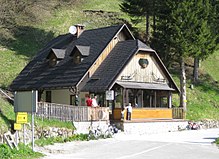
Slovenia has a wide variety of accommodation, ranging from five star hotels to secluded cottages in the mountains.
Hostels
[edit]There are hostels in all of the tourist destinations in Slovenia. The average price for a basic bed in a dorm is €10-20. Quite a few student dormitories (dijaški dom) are converted into hostels in the summer, but these tend to be poorly located and somewhat dingy.
Mountain Huts can be found in Triglav National Park, and they are very warm, welcoming and friendly. Information about these huts can be found at tourist information offices who will also help you plan your walks around the area and phone the hostels to book them for you. The only way to get to the huts is by foot, and expect a fair bit of walking up hills, as the lowest huts are around 700 m up. There are clear signs/information around stating how long it will take to travel to/between all the huts indicated in hours.
Tourist farms
[edit]Tourist farms can be found around Slovene countryside and usually they offer wide selection of traditional food, local wine, different sport activities etc. They also offer opportunities to experience real traditional countryside life.
Camping
[edit]Camping is not permitted in the national parks of Slovenia, but there are various designated camping grounds. It's advisable to take a camping mat of some sort, as nice, comfortable grass is a luxury at camp sites and you're much more likely to find pitches consisting of small stones.
Learn
[edit]Slovenia has four universities, located in Ljubljana, Maribor[dead link], Koper, and Nova Gorica[dead link] as well as several independent colleges (eg BSA Kranj, Bled).
The university in Ljubljana is the oldest, largest and most well-respected teaching institution in the country. The University of Ljubljana also contains 3 art academies: Theatre and Film; Music; Fine Arts. Various recognized international charts list the University of Ljubljana in the top 3% of universities worldwide.
Work
[edit]If you are a citizen of a country that is a part of the European Union or the EFTA, you may work in Slovenia without any restrictions whatsoever. Everyone else requires a work permit to work in the country.
Finding work in Slovenia is a difficult endeavour, even for the Slovenes themselves. The labour market is so competitive that many Slovenes often move abroad for work. In addition, Slovenia isn't exactly thought of as a destination for building a career since it has a small population and a small economy.
It's possible for English-speaking graduates to get work in a Slovene school teaching English for around a year in a scheme similar to Japan's JET programme.
Stay safe
[edit]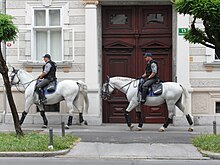
Slovenia is one of the safest countries you can visit, but be aware of your surroundings in parts of Ljubljana.
The nationwide emergency number is 112. To call police, dial 113. There are emergency telephones interspersed along the main motorways. You can find the closest SOS-phone by the arrows on the reflection posts.
People may get a bit aggressive in crowded bars and discothèques, and it is not uncommon to be grabbed or groped.
Petty theft can occur everywhere. Don't worry about it, just don't leave your watch on the car seat while you go kayaking.
Stay healthy
[edit]There are no unusual health concerns in Slovenia. Hygiene standards are high and tap water is potable.
While in nature, always use tick repellents, due to the Borreliosis and Meningitis danger. Borreliosis is very widespread in the country.
There are two species of venomous adders in the Julian Alps. You are unlikely to be bitten, but if you are, you should seek medical help as antiserums are available (although actually seldom administered). In the forests in the south, you may encounter a bear; Slovenia contains the highest bear population in Europe, but attacks are very rare. Normally, in countries that have been domesticated for several thousand years, the indigenous wild fauna will be either very skittish or very comfortable with humans. It depends on the area you are in, of course, but use your head. If you go camping in the Julian Alps and bring a lot of sausage and bacon, chances are you will attract some unwanted visitors.
Respect
[edit]Slovenians are generally open and friendly, so don't hesitate to address people as those younger than 50 understand English and will be eager to help you. You will impress them if you try using some basic Slovenian words. Slovenian is rarely spoken by foreigners, so your effort will be appreciated and rewarded.
Slovenians will insist when offering something, as "no" doesn't always mean "no," they just think it's polite for you to refuse, and polite for them to insist. Don't worry unnecessarily, but still you should take some normal precautions to study your host first.
Slovenians are proud for having preserved their national identity (especially the language) in spite of the pressures from neighboring nations in past centuries. Due to their economic success as well as historical and contemporary cultural bonds to Central Europe, they usually don't like their country to be described as part of "Eastern Europe". While Slovenian is closely related to Serbian and Croatian, it is not the same language. Another common misconception is that Slovenia was part of the Soviet Bloc, while it was in fact the northernmost country of Yugoslavia, which was neutral during the Cold War. You can, however, freely discuss these topics; just be aware that you can hear contrasting sides of the story, depending on who you talk to and his/her political affinity. There is still a strong division among leftists and rightists. Be careful if entering a discussion on open territorial issues with Croatia or on the Slovenian civil war during WWII and its aftermath. Consider these controversial topics a taboo.
Due to Slovenia's history as part of Yugoslavia, resentment towards Serbia and Russia is high. Try to avoid being overly enthusiastic about either country, as it can quickly arouse strong emotions among locals.
There is an active lesbian and gay scene in Slovenia. As elsewhere in this part of Europe, homosexuals are generally safe, although there have been a few reported attacks in the past. Be cautious in the evening and during the night, especially in cities. Women/girls holding hands are considered normal and a sign of friendship.
Practical advice:
- If you are invited to dinner at someone's home, bring a bottle of good wine. It's expected to give a compliment to a cook. Do it before you are asked if you liked the meal!
- Slovenians generally wear slippers at home, so take your shoes off when you enter. They will offer you slippers or insist you keep the shoes on. They'll normally be very gracious, knowing that you are a visitor and don't know all of their customs, but try not to be ignorantly callous.
- It's normal to shake hands when introduced to someone. Don't try to make a kiss when introduced, though in the younger generation, kissing and hugging is not uncommon between friends.
- The Slovenian Alps (especially the highest peak Triglav, named after a Slavic god) are a national symbol. Slovenia is the only country to have its highest peak on the national flag.
- It's common to greet people with Dober dan (Good day) when you meet in the mountains, and to say Srečno (Good luck) when you depart. There is a strong spirit of camaraderie in the mountains.
- It's also polite to say Dober dan to people passing by in small towns and villages.
Connect
[edit]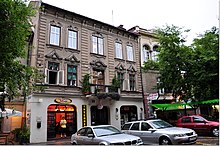
Telephone
[edit]The international calling code for Slovenia is 386, and the prefix for international calls is 00; the area code prefix is 0. Some number blocks are reserved for special use: 080 are toll-free numbers and 090 are commercial services, which are usually expensive.
Mobile networks use the common European frequencies (900 and 1,800 MHz for GSM/LTE and 2,100 MHz for 3G; 800 MHz is planned for LTE). Two major Slovenian mobile companies, Mobitel and Simobil, provide an excellent coverage in GSM and 3G, but 3G can be unavailable in mountainous regions. Roaming between European phone companies is becoming cheaper due to the EU regulation setting a maximum of €0.29 per minute for calls made and €0.09 for calls received, while calls to or from non-EU providers remain expensive. Slovenian pre-paid SIM cards are also available in supermarkets and gas stations.
Telekom Slovenije operates around 3,500 phone booths. They unfortunately do not accept coins but require the use of cards costing €3–15.
Internet
[edit]Slovenia is generally well covered by inexpensive broadband internet due to fierce competition between multiple companies. Internet cafes are thus common in cities and internet access is offered by most hotels and hostels.
A free wireless internet network is also being set up in some cities by volunteers (Ljubljana, Maribor, Nova Gorica). You can use it if you have a computer or a WiFi enabled phone.
Postal Services
[edit]The offices of Pošta Slovenije are ubiquitous. Look for French horn-like signs on dark yellow background. Delivery takes one day within Slovenia, a few days within Europe and (usually) less than two weeks worldwide. DHL is also available.
Postal rates
[edit]Inland postcard: €0.69 (value of the "B" stamp)
Inland letter (up to 20 g): €0.55 (value of the "A" stamp)
International postcard / international letter (up to 20 g): €1.22 (value of the "C" stamp)
International airmail postcard / international airmail letter (up to 20 g): €2.19
Newsagents or shops selling postcards usually sell stamps, too. If this is not the case, you can always buy them at a Post Office.
For airmail, you will have to go to the Post Office and ask for prednostno. You can pay directly at the counter or attach proper stamps.
Rates correct as of January 2021.


